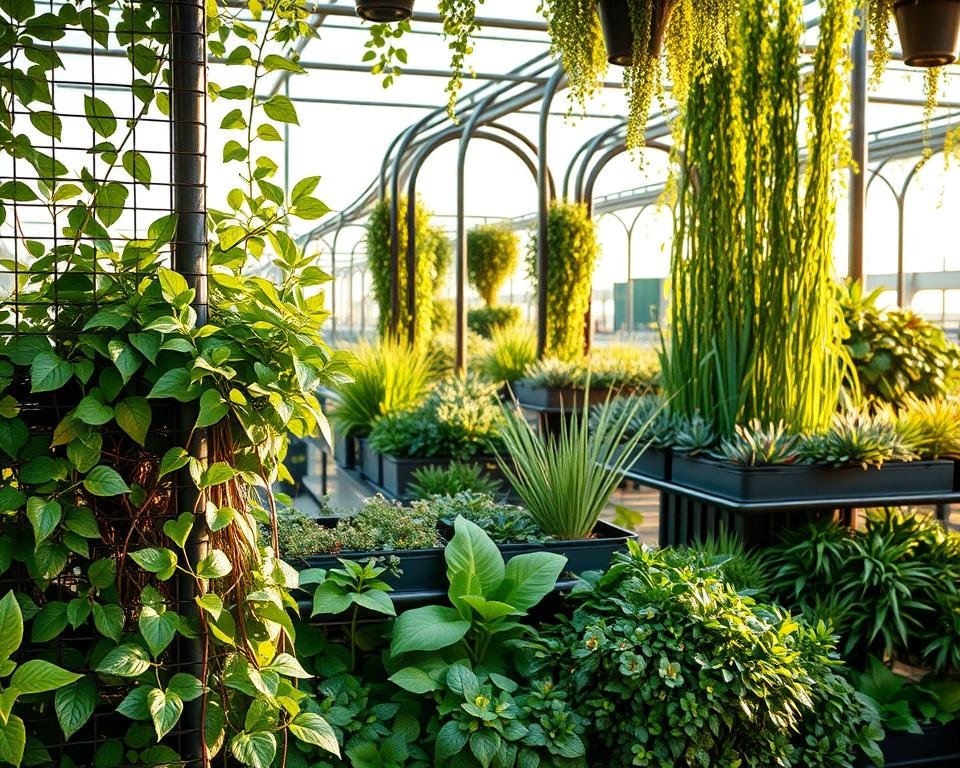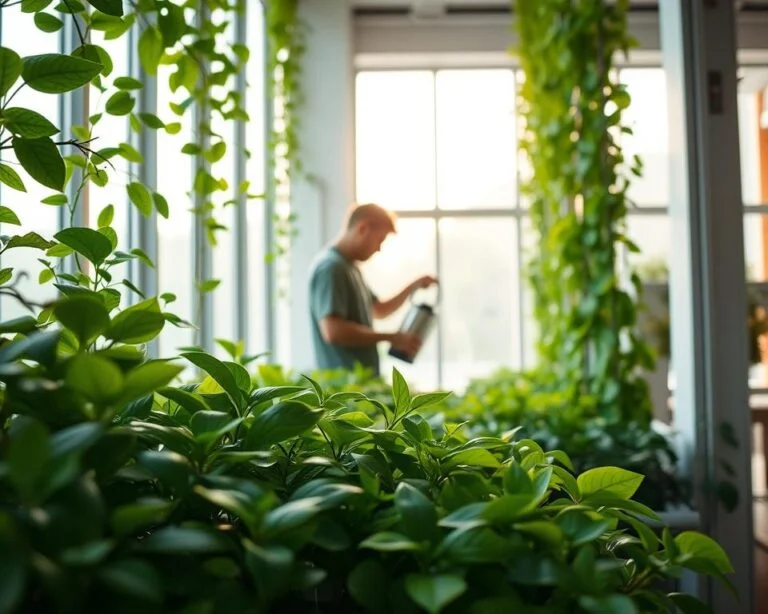Using Metal Structures for Modern Vertical Gardens
Every urban dweller dreams of a green sanctuary, but space constraints often crush those hopes. Imagine turning your tiny balcony or barren wall into a lush, vibrant vertical garden. This can bring life to your living space. Metal structures have changed how we design gardens with innovative structural steel.
Vertical gardens are more than just pretty. They are a powerful solution for urban areas where traditional gardening seems impossible. With metal structures, you can create stunning green spaces. These spaces purify air, reduce noise, and offer a visual break from concrete.
The magic of modern vertical gardens is their mix of durability and beauty. Metal structures support plants well, letting you design intricate green walls. These walls can turn ordinary spaces into extraordinary living environments. Whether you live in a city apartment or a suburban home, vertical garden design offers endless possibilities.
Key Takeaways
- Metal structures provide essential support for vertical garden systems
- Vertical gardens improve air quality and urban living spaces
- Structural steel design enables creative and functional green installations
- Vertical gardens can be adapted to various urban and residential settings
- Plants in vertical gardens can reduce noise and enhance environmental well-being
Understanding the Fundamentals of Vertical Gardens
Vertical-gardens are changing how we see green spaces in cities. They use steel to create beautiful views in small areas. This is a new way to use space.
The vertical farming market is growing fast. It was worth $5.6 billion in 2022 and could hit $35 billion by 2032. This shows how big the potential is for these gardens.
Benefits of Vertical Garden Systems
Vertical-gardens have many benefits for cities:
- They save a lot of water (up to 90% less than regular gardens)
- They make the most of small spaces
- They improve the air we breathe
- They make buildings look better
Essential Components for Success
To make a strong vertical garden, you need a few key things:
- A strong support system
- A good irrigation system
- The right plants
- Enough light (6-8 hours a day)
Environmental Impact and Sustainability
Vertical-gardens are good for the environment. They cool cities down, help animals, and offer new ways to be green.
| Vertical Garden Type | Water Efficiency | Space Utilization |
|---|---|---|
| Hydroponic Systems | Up to 90% reduction | 10% of traditional farming space |
| Aeroponic Systems | Up to 75% reduction | Compact vertical design |
By 2050, 70% of people will live in cities. Vertical gardens are key to making cities sustainable.
Metal Structures: The Foundation of Modern Garden Design
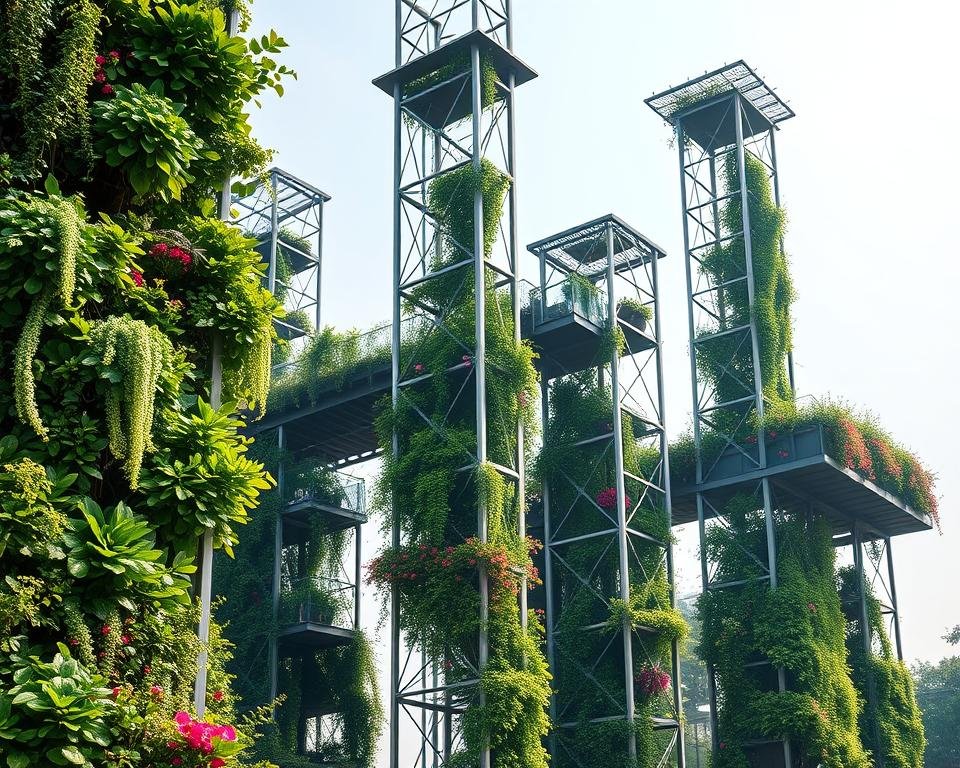
Steel construction has changed garden design, bringing new ideas for vertical gardens. Metal buildings have made outdoor spaces more functional and beautiful. They offer strong support that looks good too.
Metal structures are great for vertical gardens. They are strong and can be shaped in many ways. This makes them perfect for creating lively green areas. Welding lets designers make detailed and strong frames for plants.
- Stainless steel wire cabling systems create flexible vertical growing environments
- Custom metal frames allow for unique architectural integration
- Modular metal designs adapt to different garden sizes and styles
The 20th century’s steel frame construction changed outdoor design. Lightweight yet strong metal structures help make amazing vertical gardens. These gardens use space well and look great.
Metal structures transform ordinary spaces into extraordinary green landscapes.
Choosing metal for your garden has many benefits:
- They last long against weather
- They don’t rust with the right treatment
- They need little care
- They look modern and sleek
When picking metal for your garden, think about your space and plants. Modern welding lets you customize these structures. They support your garden for a long time.
Planning and Design Considerations for Vertical Gardens
Creating a successful vertical garden needs careful planning and design. Your approach to steel framing and structural steel design is key. Professional metal erection techniques are vital for building strong and lasting vertical garden systems.
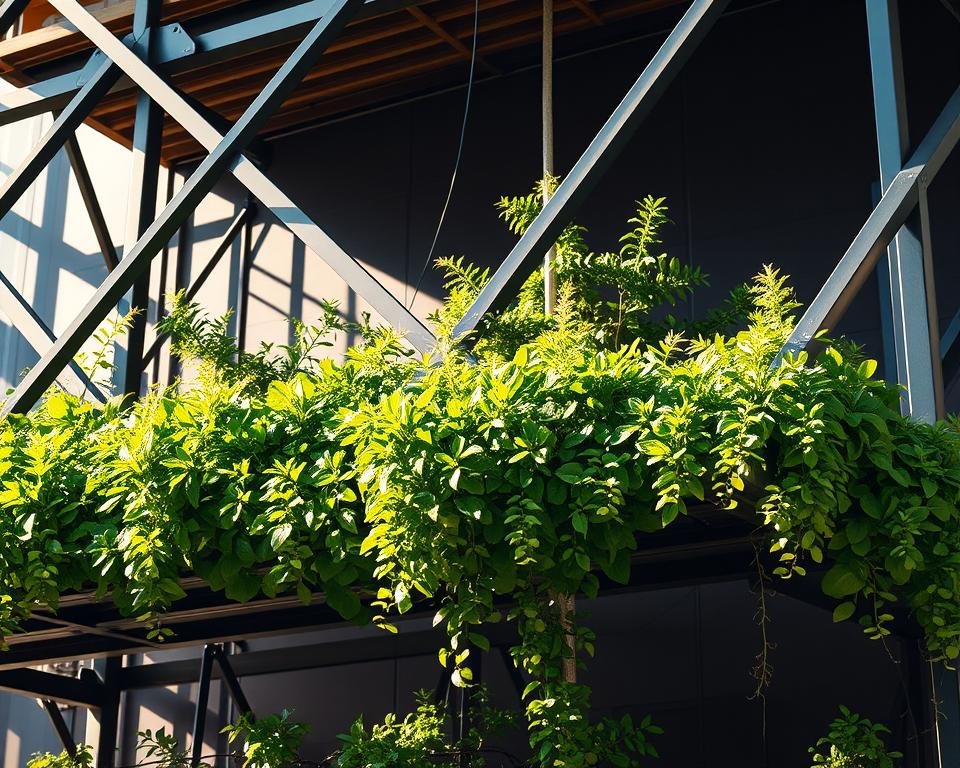
Understanding the key parts of vertical garden design is crucial. It ensures plants grow well and the structure stays strong. Success depends on several important factors:
- Proper weight distribution
- Effective drainage systems
- Strategic material selection
- Comprehensive support structures
Weight Distribution and Support Systems
Vertical gardens need careful engineering. They can hold weights from 100-200 pounds per square foot. Your steel framing must handle these loads while looking good.
| Support Structure | Weight Capacity | Recommended Use |
|---|---|---|
| Lightweight Metal Frames | 100-150 lbs/sq ft | Indoor Gardens |
| Heavy-Duty Steel Supports | 150-200 lbs/sq ft | Exterior Installations |
Drainage and Irrigation Requirements
Good water management is key in vertical garden design. Drip irrigation systems can cut water use by 30-50%. Drainage channels placed right can stop soil erosion and keep plants healthy.
Proper irrigation is the lifeline of any successful vertical garden installation.
Material Selection and Durability
Choosing the right materials for metal erection is crucial. Corrosion-resistant steel and aluminum are great for strength and less upkeep. Your material choice affects the garden’s look and performance.
By combining smart structural steel design with new gardening methods, you can make a beautiful vertical garden. It will be both functional and eye-catching.
Types of Metal Support Systems and Their Applications
Vertical-gardens need advanced metal support systems that look good and work well. In steel detailing and metal fabrication, picking the right support can make your garden stand out. Welding is key in making strong frames that can handle different weather conditions.
There are many metal support systems for vertical gardens, each with its own benefits. Here are some popular ones:
- Wire Mesh Systems: Lightweight and versatile, perfect for climbing plants
- Cable Support Structures: Ideal for creating minimalist, contemporary designs
- Modular Metal Panels: Provide maximum flexibility for plant arrangement
- Gabion Walls: Combine structural integrity with drainage capabilities
Gabion structures are becoming popular in modern landscaping. They use metal containers filled with stones to create eye-catching vertical gardens. These gardens also ensure good drainage and air flow. The structural design principles of metal buildings apply to making strong vertical garden supports.
When picking a metal support system, think about the plant’s weight, the weather, and what you want your garden to look like. Each system has its own advantages, from supporting delicate plants to making bold garden statements.
Plant Selection and Growing Media for Metal Structures
Creating a successful vertical garden needs careful plant selection and growing media management. Your metal structure is a strong base for a modern design. It can turn any space into a living green area.
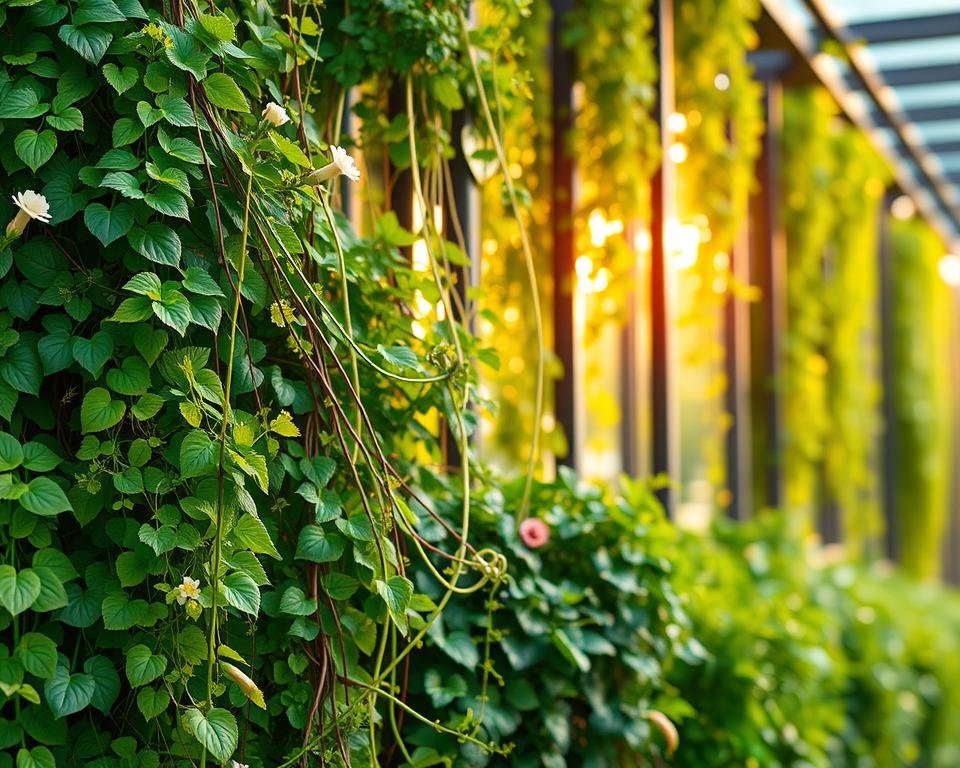
When designing your vertical garden, consider these key factors for plant compatibility:
- Light exposure requirements
- Moisture tolerance
- Root system characteristics
- Climate adaptability
Compatible Plant Species
Choosing the right plants is key for a thriving vertical garden. Some great options include:
- Succulents – Low maintenance and drought-resistant
- Trailing plants like English ivy
- Compact herbs such as thyme and rosemary
- Ferns for shadier vertical garden locations
Soil Requirements and Alternatives
Traditional soil can be heavy for vertical-gardens. Look into lightweight alternatives like:
- Hydroponic growing media
- Coconut coir
- Lightweight potting mixes
- Specialized vertical garden substrates
Maintenance Considerations
Proper maintenance keeps your vertical garden healthy and looking good. Regular pruning, checking water needs, and pest monitoring are important. They help your garden thrive on its metal structure.
Pro tip: Choose plants with similar care requirements to simplify maintenance of your vertical garden.
Installation Techniques and Best Practices
Setting up vertical-gardens with steel construction needs careful planning and precise metal work. Your steel design must meet specific needs for plant health and structure. This ensures your garden stays strong and your plants thrive.
- Assess structural load capacity before mounting
- Select appropriate anchoring methods
- Prepare robust mounting surfaces
- Ensure even weight distribution
- Create proper drainage systems
Getting ready before you start is key for a successful vertical garden. Metal work needs to be done with great care. This includes accurate measurements and smart placement of parts.
| Installation Stage | Key Considerations |
|---|---|
| Foundation Preparation | Level surface, appropriate anchor points |
| Structural Support | Robust steel framework, corrosion resistance |
| Plant Container Integration | Modular design, easy maintenance access |
Safety is very important when you’re setting up. Always wear protective gear, follow the instructions, and think about getting help for tricky projects. The success of your vertical garden depends on good planning and skilled work.
It’s smart to pick light plants, use modular systems, and make it easy to care for. Regular checks will keep your garden looking good and healthy.
Innovative Design Ideas for Metal Garden Structures
Modern design in vertical gardening turns metal fabrication into an art form. It combines industrial looks with natural beauty. Your metal vertical planter can become a stunning architectural element.
It goes beyond traditional landscaping, creating living walls. These walls serve multiple functional and visual purposes.
Strategic metal structure design allows you to mask unsightly views. It creates privacy screens that are both practical and visually engaging. By using durable metal structures, you can make long-lasting garden installations.
These installations fit well with your architectural environment.
Smart lighting systems can dramatically enhance your vertical garden’s appeal. They reduce energy costs while creating dramatic visual effects. Consider adjustable LED fixtures that highlight specific plant zones.
Or create ambient illumination that transforms your metal garden structure into an evening focal point.
Water features integrated with metal vertical planters can introduce sensory elements. Compact misting systems or small cascading elements can provide humidity for plants. They add a dynamic aesthetic dimension to your metal fabrication.
This makes your vertical garden a true conversation piece.

